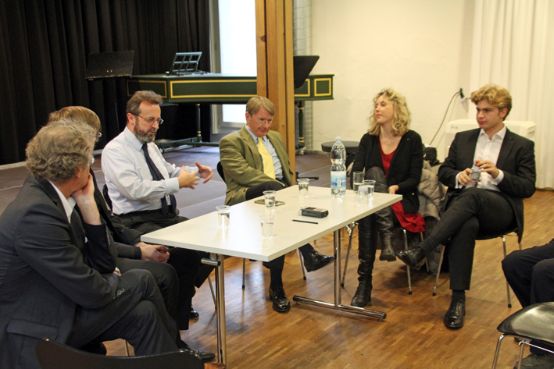Conductor Richard Wagner and the consequences
A symposium at the Bern University of the Arts examined the impact of Wagner's essay "On Conducting".

Richard Wagner published the first important treatise on conducting and interpretation. His ideas on how to perform the classical and early romantic orchestral repertoire became a benchmark for subsequent generations of conductors. How a non-systematic and often politically problematic treatise was able to develop into a conducting tradition that remains influential to this day was the subject of a symposium held by Bern University of the Arts in cooperation with the Royal Academy of Music on November 2 and 3, 2018 in Bern.
About conducting was founded in 1869 in the New Journal for Music printed in Leipzig in eight parts. Chris Walton (Bern) shed light on the circumstances surrounding the creation of this treatise, which is characterized by an anti-Semitically tinged and intellectualized language that is unable to conceal the arbitrariness, lack of planning and uncertainty of its author. Nevertheless, the treatise is one of the most influential things ever written about conducting, and no author dealing with this subject can avoid referring to Wagner. Wagner's subjective, disorganized thoughts and insights can be traced back not least to his practical work with the orchestra of the Allgemeine Musikgesellschaft in Zurich from 1850 onwards. The orchestral parts that Wagner wrote for his performance of Wolfgang Amadé Mozart's Jupiter-Symphony (KV 551) was annotated. Christoph Moor (Bern) showed what conclusions can be drawn from the entries in the part material with regard to interpretative and pedagogical approaches and where this source reaches its limits for interpretative research.
Wagner's influence
How Wagner's legacy affected subsequent generations is illustrated below by highlights of well-known conductors. As for their role model, the work of Ludwig van Beethoven also played a significant role for Wilhelm Mengelberg and Felix Weingartner. Frits Zwart (The Hague) explained how Mengelberg championed Beethoven's and Gustav Mahler's music throughout his life and what characterized his interpretations. Lena-Lisa Wüstendörfer (Basel) illuminated Weingartner's Beethoven aesthetics from two different perspectives, which for decades was sometimes regarded as the highest authority for the interpretation of his symphonies. The examination of Weingartner's orchestration of the Hammerklavier Sonata (op. 106) and the analysis of his practice of retouching shed light on his understanding of interpretation and his proximity to Wagnerian maxims. The fact that Weingartner's writing on conducting bears the same title as Wagner's shows his affinity with the "master". Weingartner saw his writing as a return to Wagner and a continuation of his approaches at a time when the battle between objective and expressive interpretation polarized the music world.
Anton Webern's annotated scores have not survived in large numbers. Nevertheless, the insight into his "self-preparations", presented by Regina Busch (Vienna), revealed an interpretative aesthetic that repeatedly refers back to Wagnerian principles. In particular, the questions of tempo modification and tonal transparency seem to have been central to Webern's interpretative approaches, which were anchored in the New Viennese School. Christopher Fifield (London) described Hans Richter as Wagner's factotum. In fact, Richter's career was shaped by the person and music of Wagner and his interpretative ideas. Although these cannot be deduced directly from annotations in scores, Richter, as a Wagner conductor and copyist of the Meistersinger-score deeply internalized Wagner's ideas. Incidentally, the Meistersinger transcription holds the amusing secret that Wagner notated the very last note, the C of the double basses, himself.
Schenker's criticism
Heinrich Schenker's response to Wagner's writings About conducting and For the performance of Beethoven's Ninth Symphony from 1873 was a review with the title Beethoven's Ninth Symphony. A presentation of the musical content with ongoing consideration of the performance and the literature. In it, Schenker writes extensively about practical performance aspects. He insinuates that Wagner's theatrical approach to this symphony destroys the nature of the work. Roger Allen (Oxford) spoke about the different readings of the Beethoven score and used Wilhelm Furtwängler's interpretation to show the practical implementation of Schenker's idea. This is based on the assumption that a performance lives from a recreative process of improvisation, which is fused into an organic whole.
Raymond Holden (London) focused on Richard Strauss as a Mozart conductor. In addition to recordings and texts, the Bülow pupil's annotated scores played an important role. It was impressively demonstrated that interpretation research has to deal critically with annotations. The comparison between Straussʼ recordings and his entries in the scores proved to be not always congruent. The analysis of the annotations can therefore at best provide a snapshot and merely serve as a stimulus for a creative approach to the work.
Creativity of interpretation approaches
Raymond Holden demonstrated in a public workshop how such creativity, which is inspired by a wide variety of interpretative approaches, can manifest itself in practice. The orchestra, made up especially for the symposium of students from the music academies of Bern, Lucerne and the Royal Academy London, played Symphony No. 29 (KV 201) and the Jupiter-Symphony (KV 551) by Mozart in various interpretations corresponding to the annotations of different conductors. This made it possible to vividly experience how Wagner's basic ideas of transparency and tempo modification, although realized in different ways, represent central parameters of a lively and expressive interpretation.
The concert with the two symphonies under the direction of Raymond Holden was the brilliant conclusion to the stimulating symposium, which also marked the end of the Bern project supported by the Swiss National Science Foundation. Annotated conducting scores as primary sources for research into the history of interpretation in the 19th and 20th centuries: Richard Wagner and his successors in the Central European conducting tradition decided.








